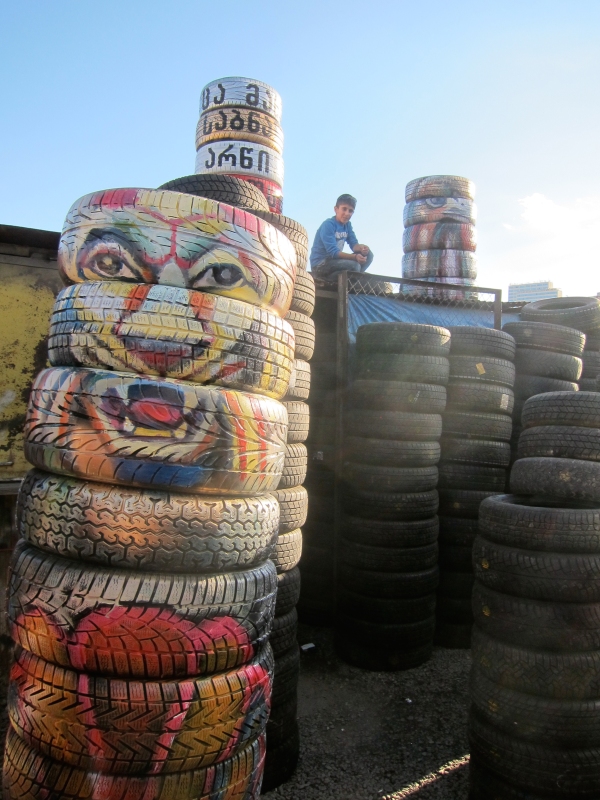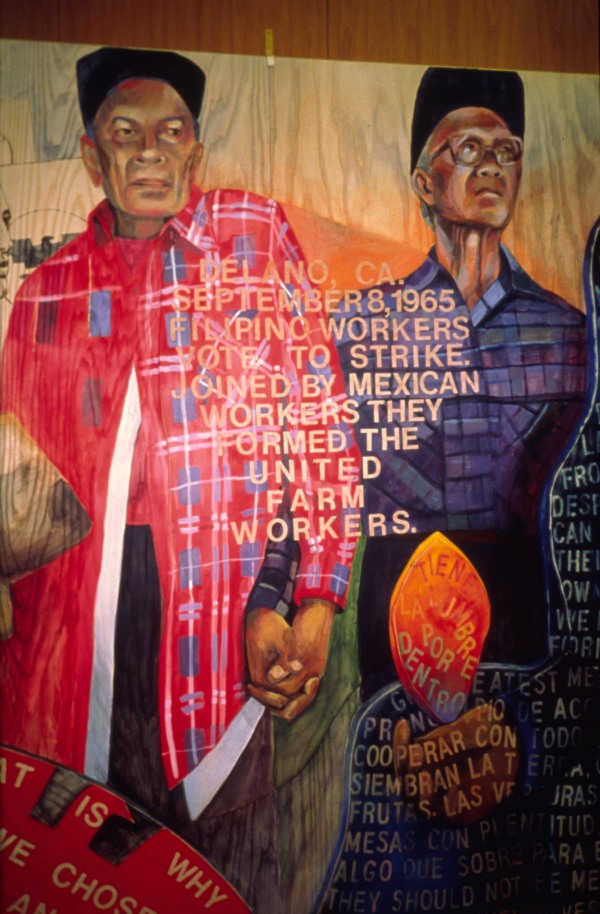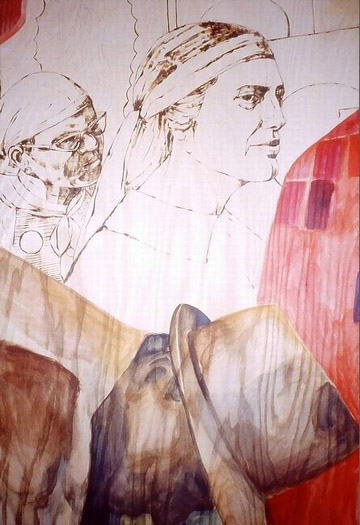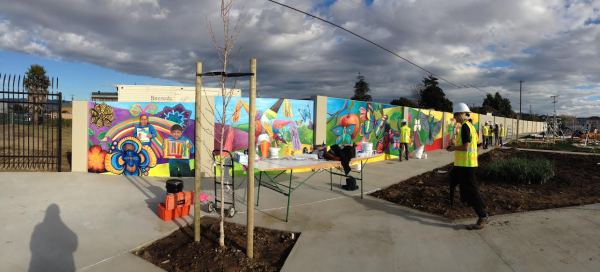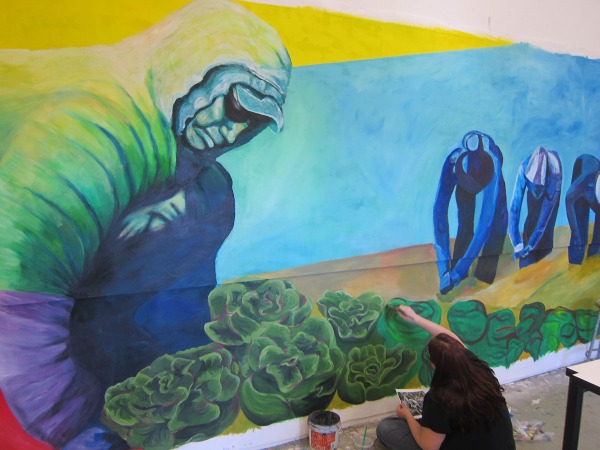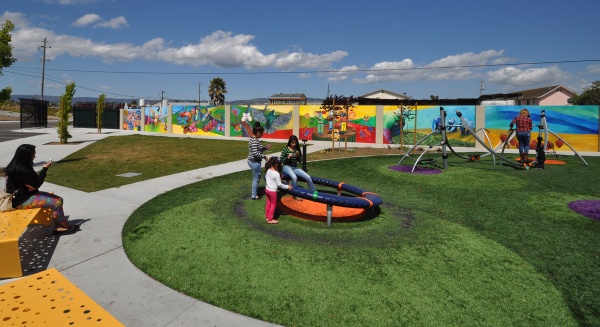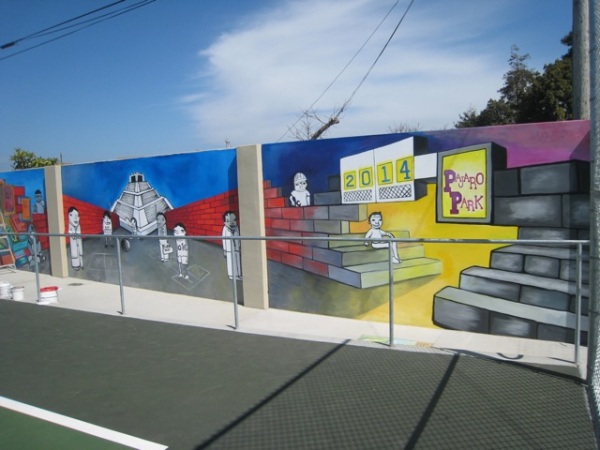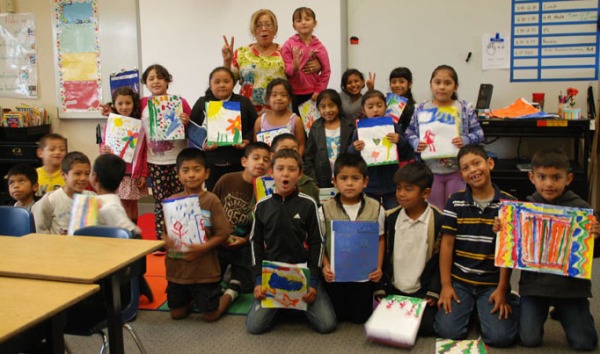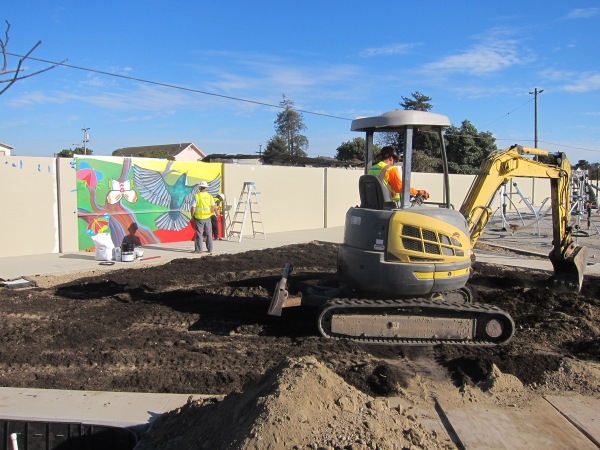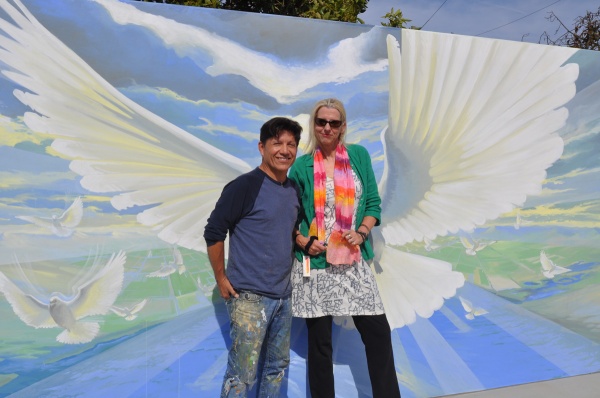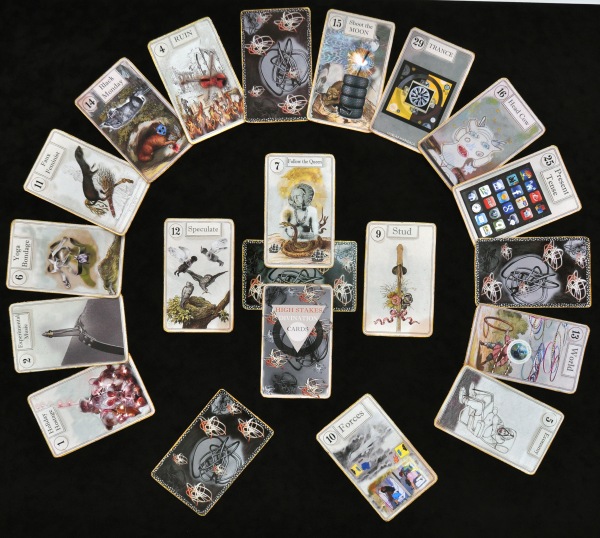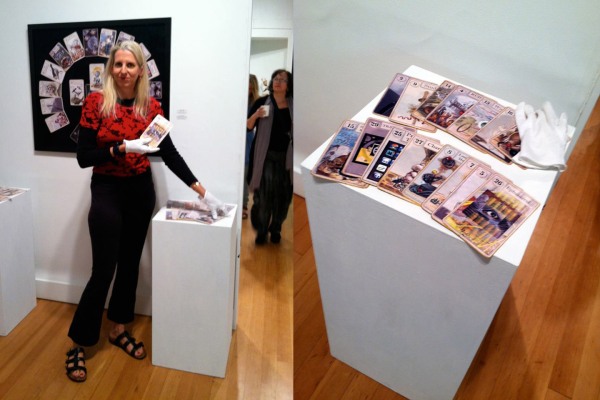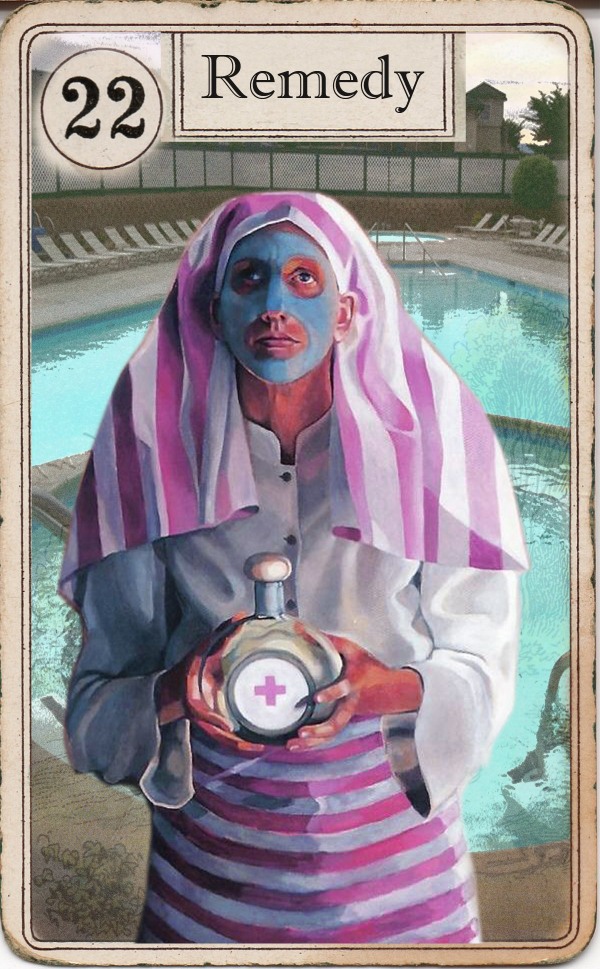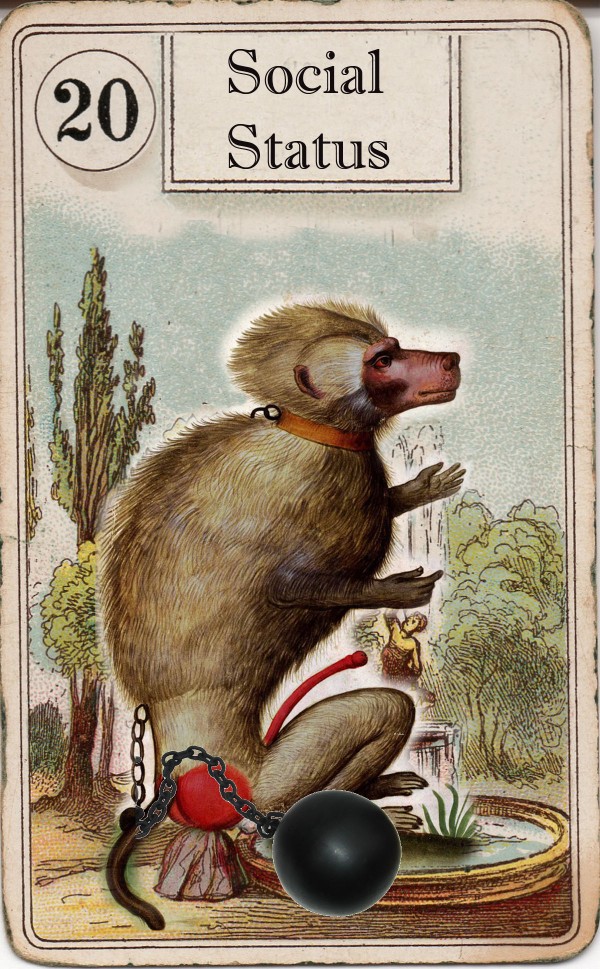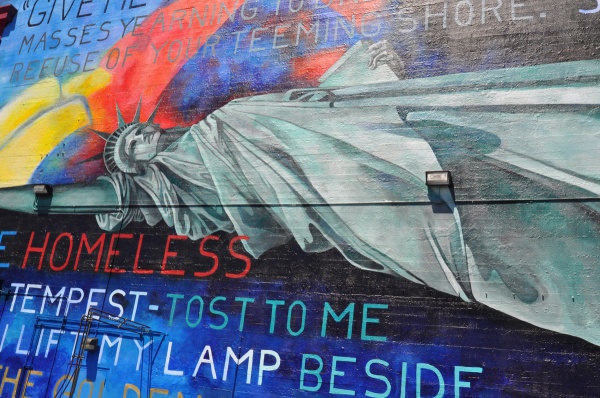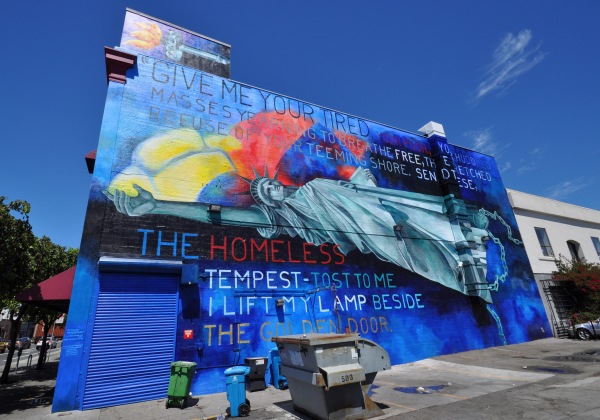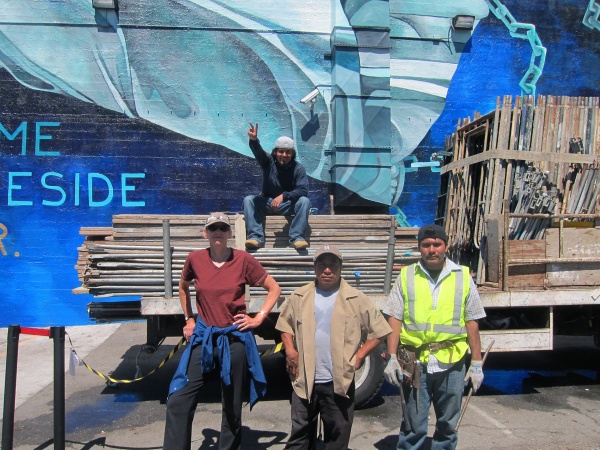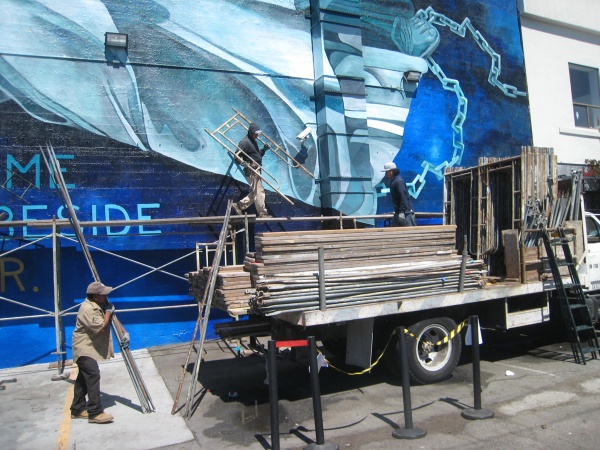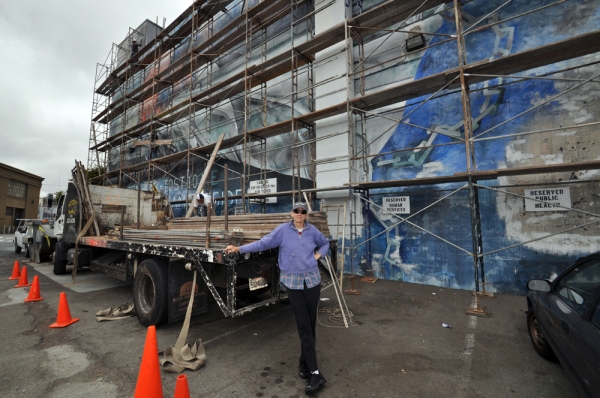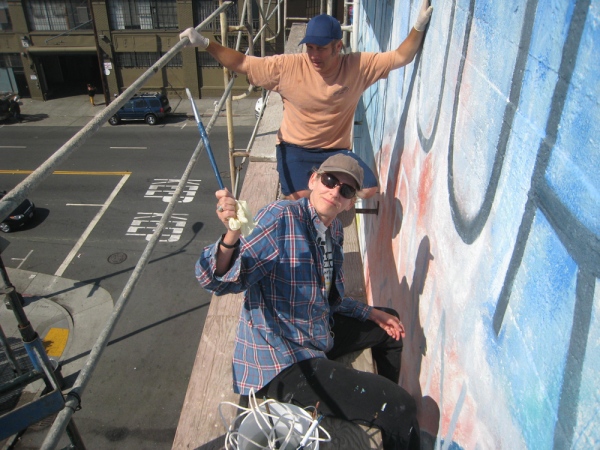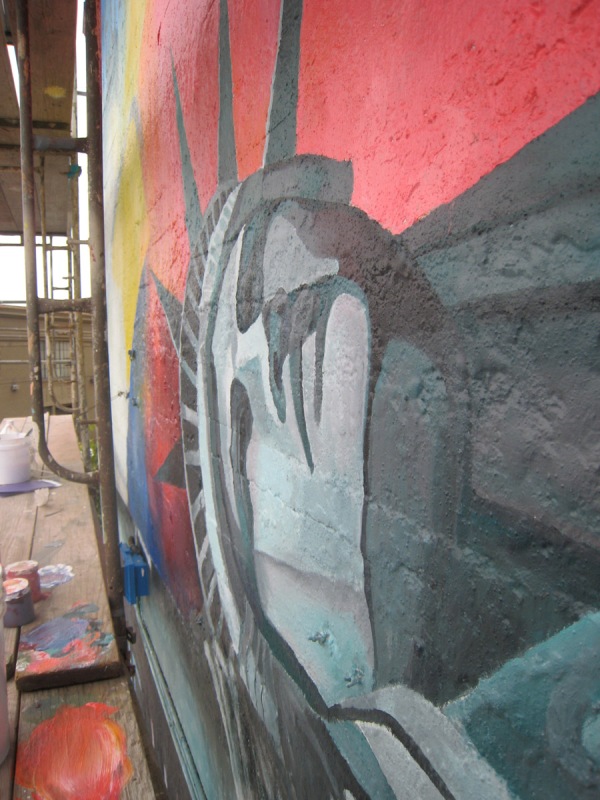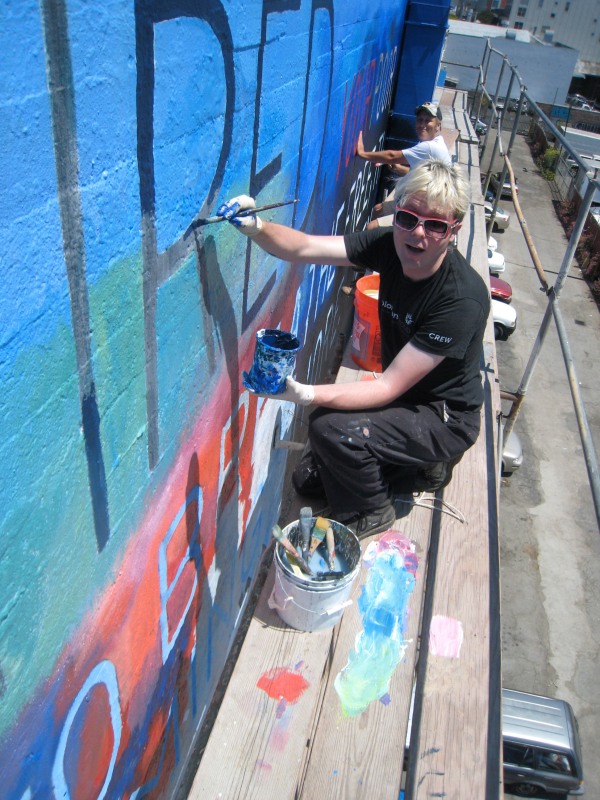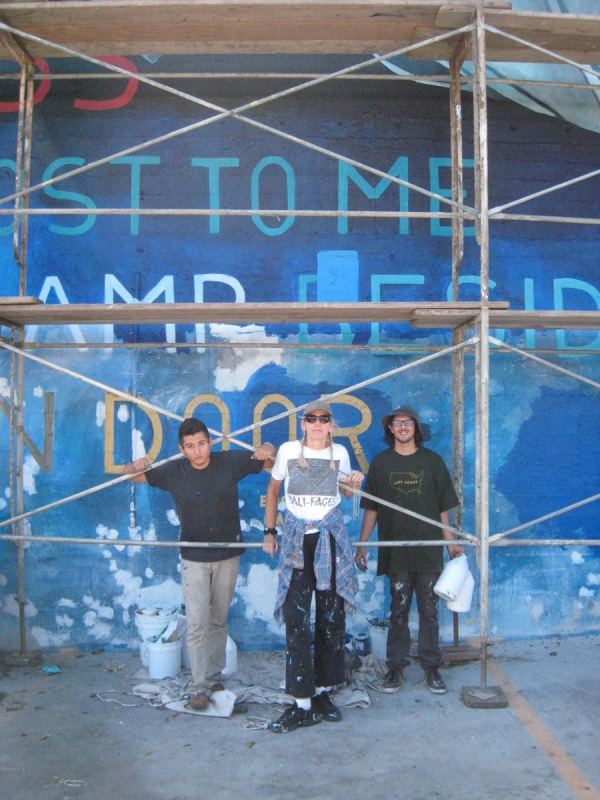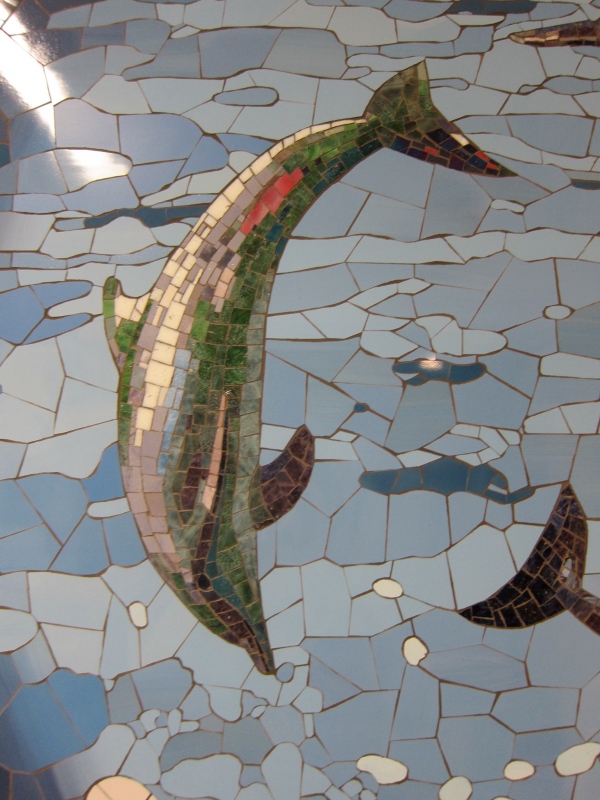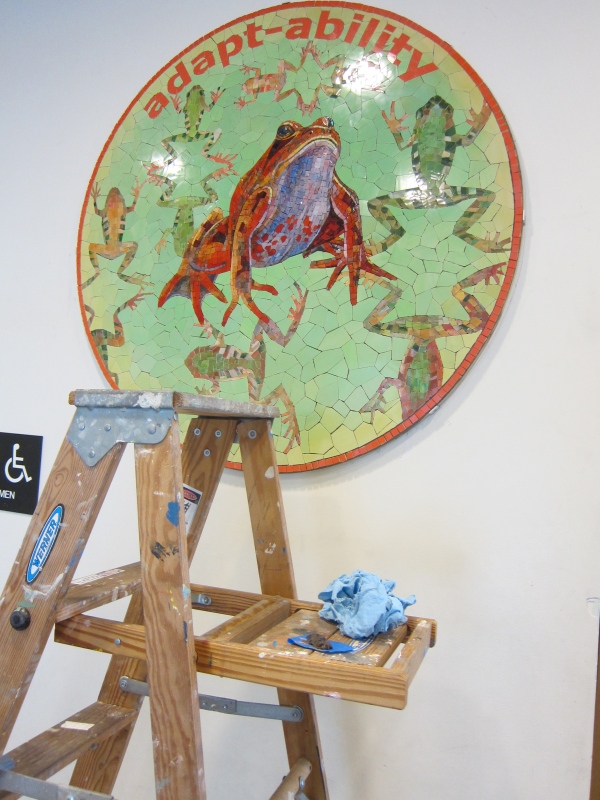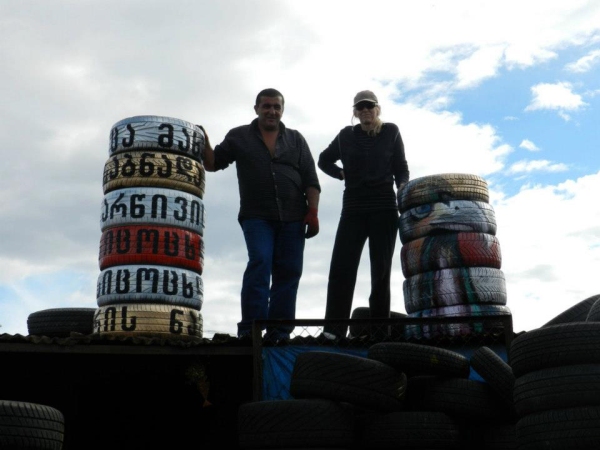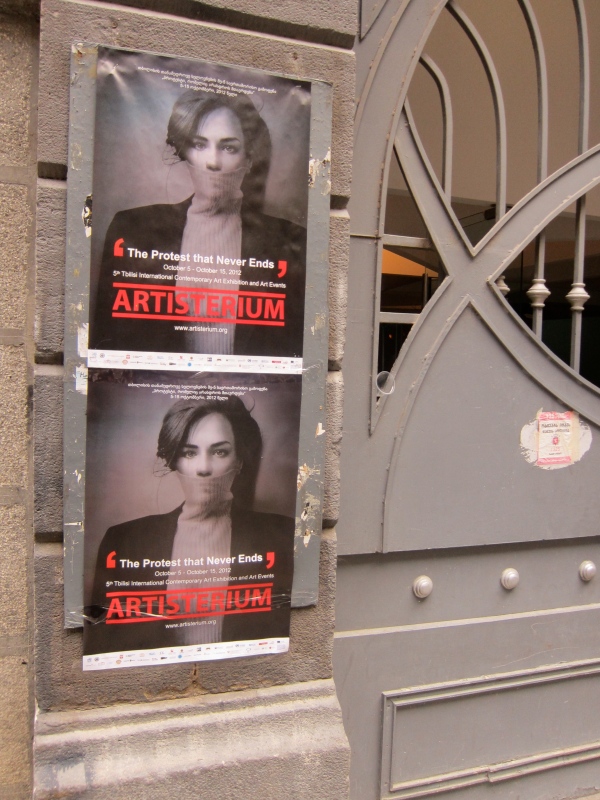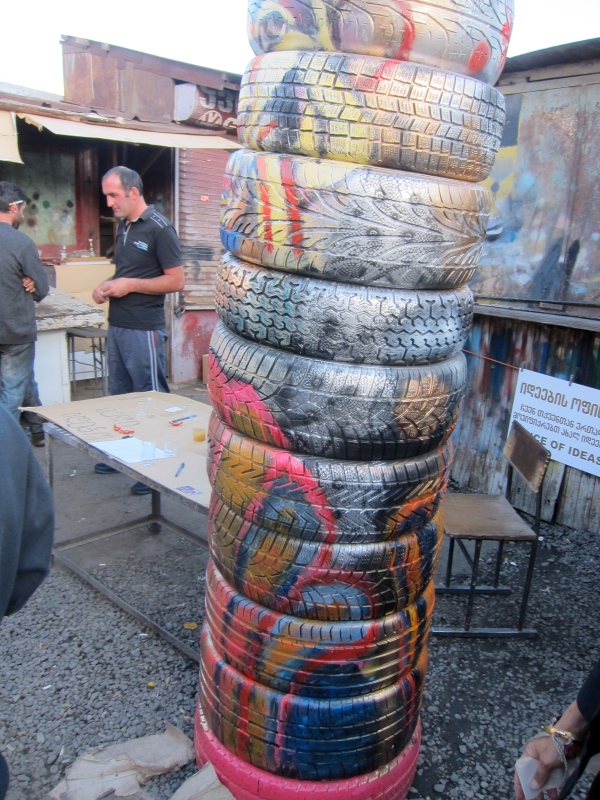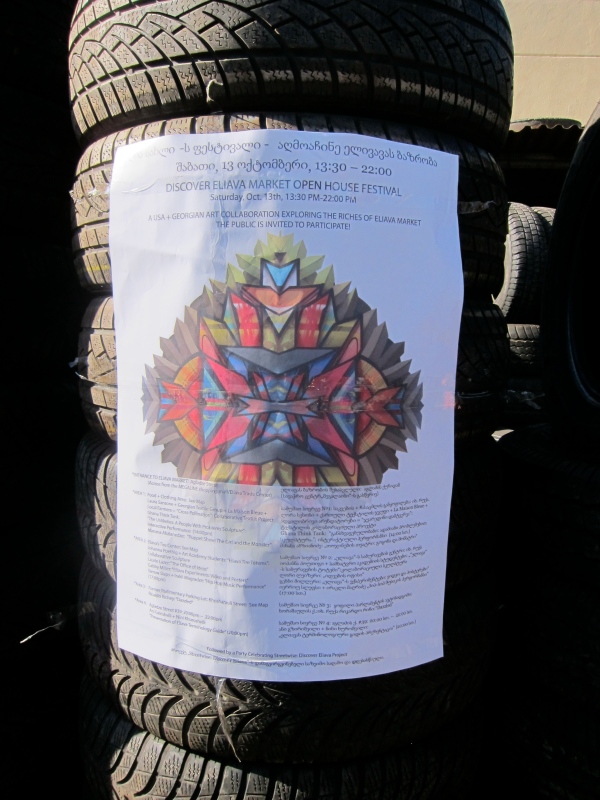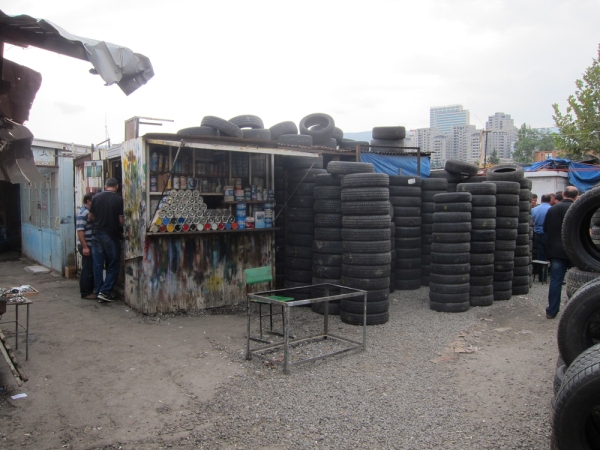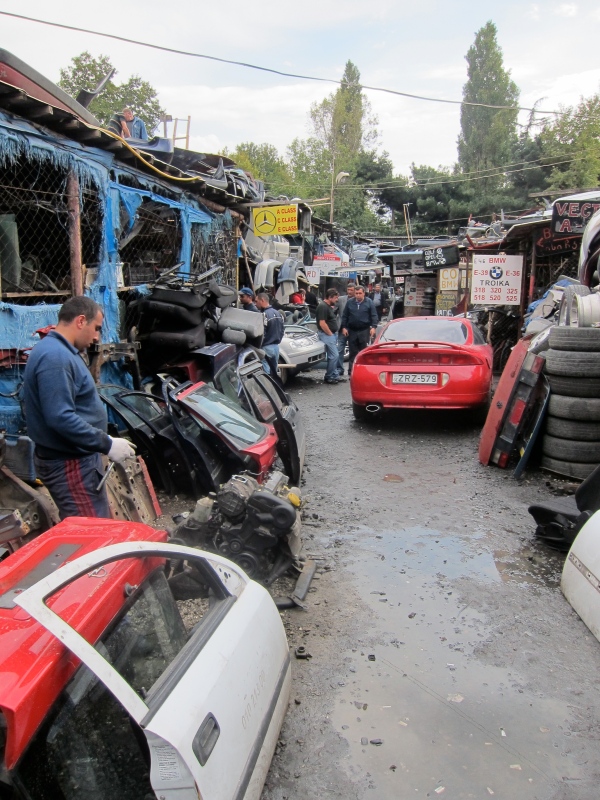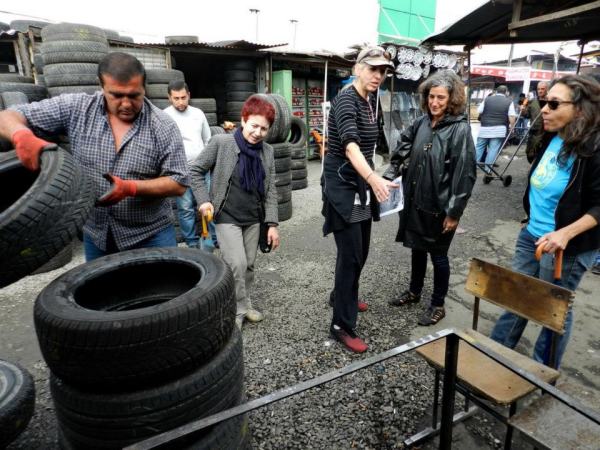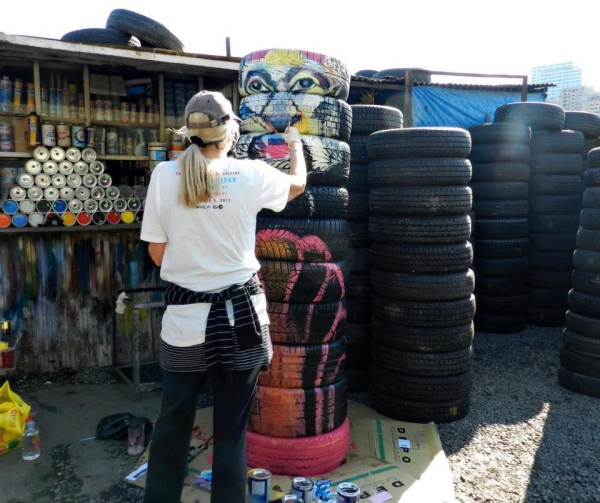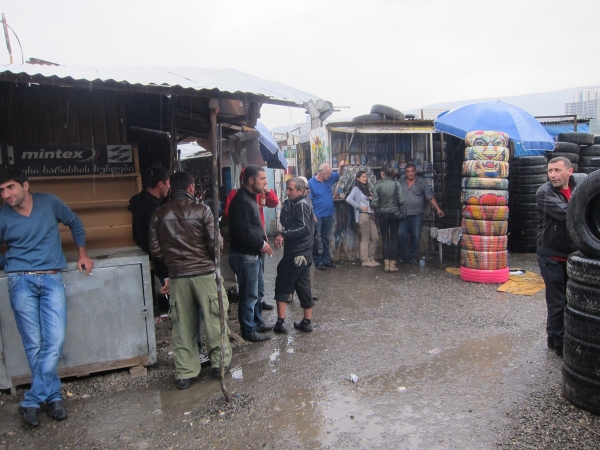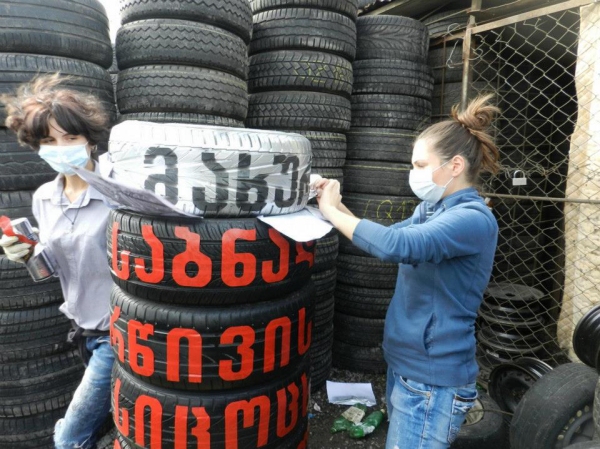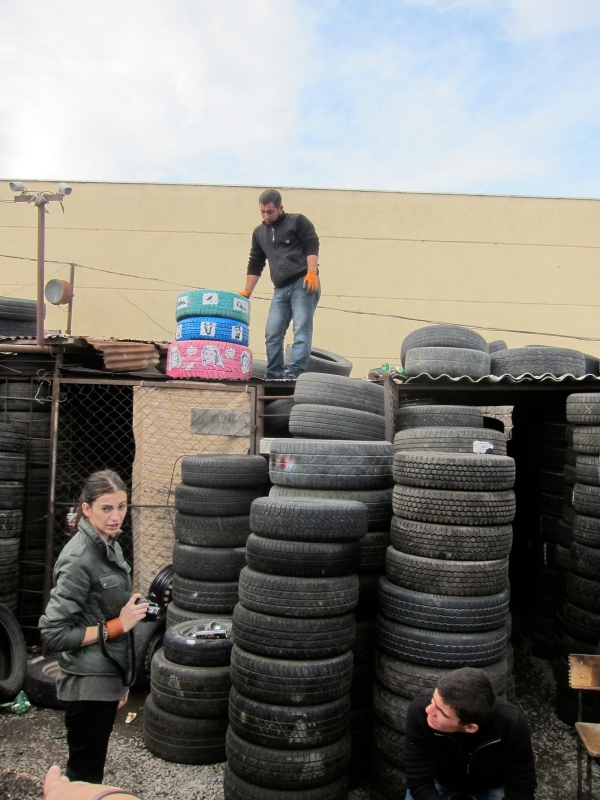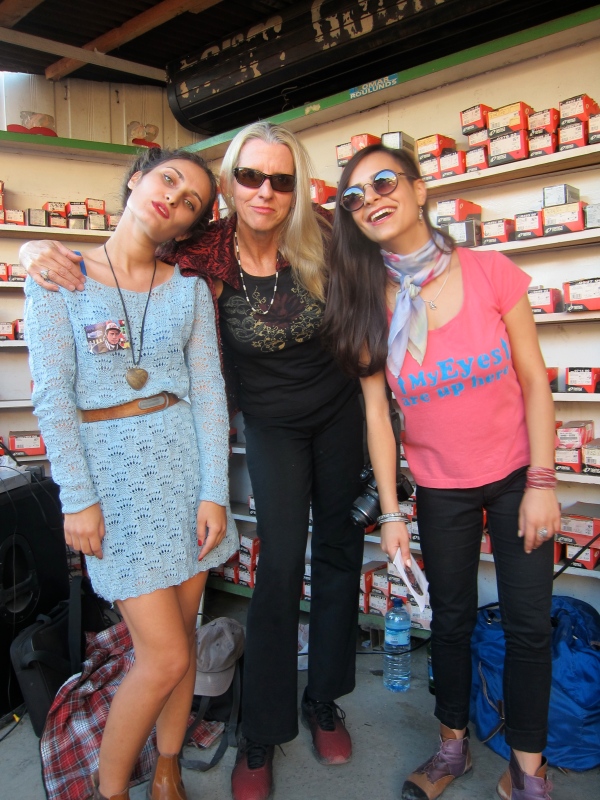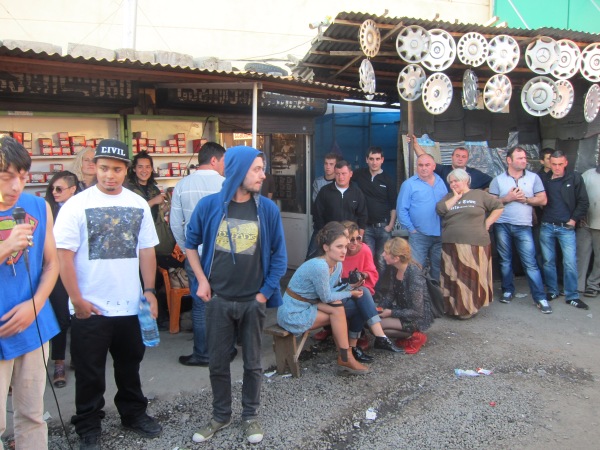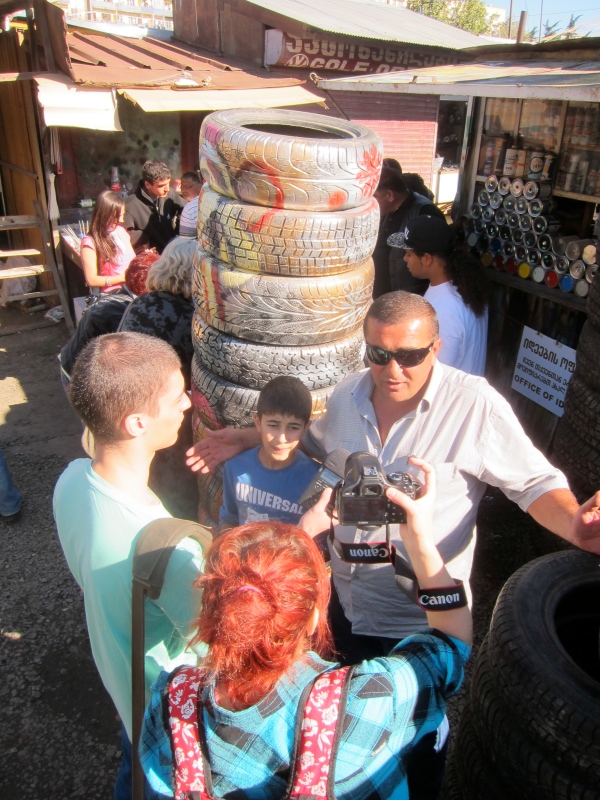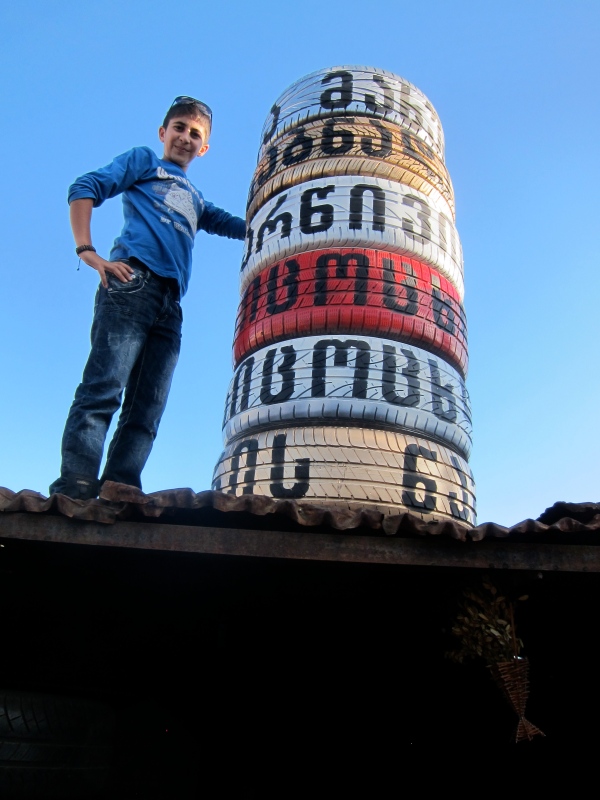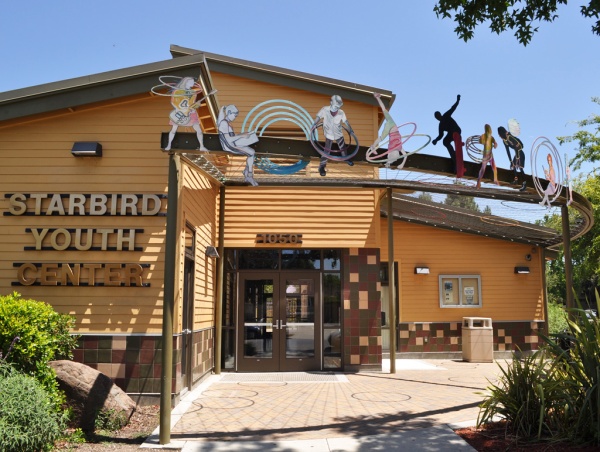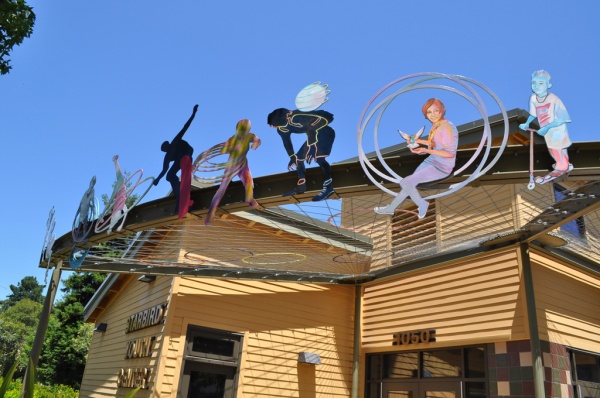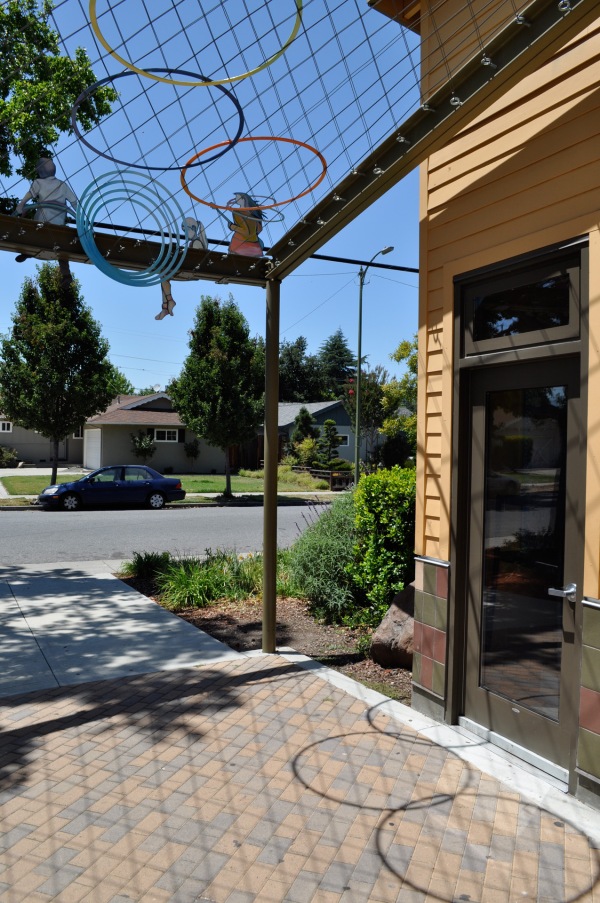Naked Dahlia: The Harvey Milk Mural
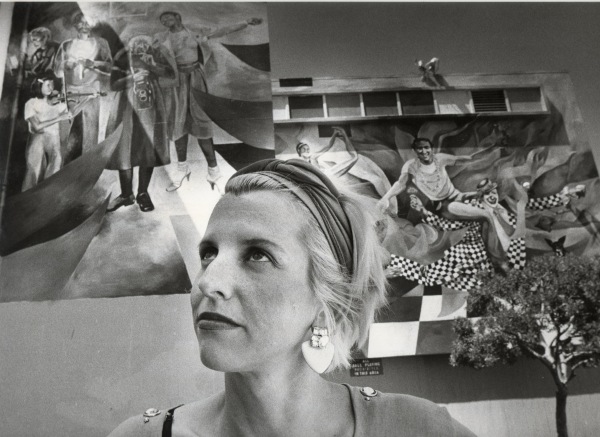 NAKED DAHLIA
NAKED DAHLIA
I can’t grow dahlias. I have tried several times but they never poke themselves up through the dirt. The Harvey Milk Mural wall was discovered by my dear friend Rick Terry. It was not far from the dirty beige apartment building we lived in on the panhandle, in the Haight Ashbury. This site was an obvious location for a mural to honor the first gay and tragically shot San Francisco Supervisor. The Harvey Milk Rec Center in Duboce Park overlooked a grassy knoll where dog owners scooped up after their hounds with Harvey’s famous pooper scooper. The Rec center had a photo studio, a tribute to Harvey’s camera store. When I met my friend Rick he introduced himself as a “Castro Clone”. He was a Tsimoso, a gossip, a fallen angel with red bird nesting on his head for his 30th birthday party. I had reluctantly let him use my fancy cut glass pitcher to make his tequila sunrise mix. When I heard the crash a few minutes later I knew my grandmother was right about giving me nice wedding gifts and my reckless lifestyle. Rick wailed his apology but I still miss that pretty present.
We were young and sinfully silly but I was serious as I started down the road of creating the Harvey Milk Memorial. The wall that rose up over the park was a perfect square with a long view. I called up Harvey’s “widow” Scott Smith and went to meet with him, go through old pictures and hear the stories. Harvey loved to play the clown dressed up in full regalia. He was an instant classic with his flower lei as he rode in the convertible, Jackie Kennedy style for the victory parade. He adored his big black dog “the Kid”. He was exuberant, full of life, humor and promise. Should this mural be a tragedy or a victory, a reminder of what was lost or what was won?
Rick loved dahlias so at the center of the mural design I planted a glorious fuchsia bloom. Like a Hindu goddess floating on petals, Harvey rode on the shoulders of his clown self, flowers around his neck and the Kid in attendance. I had gotten the permission for the wall, gone door to door to show my design and raised a few thousand dollars to cover the scaffolding and paint. The design had passed through the flaming hoop of the San Francisco Arts Commission review. When the time came to get final approval from the San Francisco Rec and Park Department a snake came out of the grass of Duboce Park. Across from the wall out of the corner of his eye, if he angled himself just so at his window, Deputy Mayor Rotea Gilford could see that bare wall. He wanted it to stay that way, naked, concrete, meaningless. No matter that most everyone was excited about the idea. He was a friend of Mayor Dianne Feinstein who had taken over after the fateful shooting of Moscone and Milk. He spoke to the Mayor and the fight was on. The Castro neighborhood rallied, petitions were signed and articles published. “ Her back against the Wall” was the headline. The bad news was the mural project was at risk, the good news was people cared about it.
When the five Rec and Park Board members met at McLaren Lodge, at the entrance of Golden Gate Park, the carved mahogany door shut out the crowd and radio newscasters waiting for the decision. By one vote they said yes to the mural but shifted it to the side wall overlooking the basketball court so Rotea would not have to look at it.
By the time the mural was done Rick had full blown AIDS. It was the late 1980’s. For the unveiling, Gilbert Baker, designer of the rainbow Gay Pride flag and member of the Sisters of Perpetual Indulgence made a huge purple curtain with a polka dot trim to drape the mural. It billowed up and around that day revealing parts of the painting in a sweet tease. We had a dog fashion show and Sista Boom marched in full percussion. Up and coming politician Tommy Ammiano and other luminaries from the community were judges for the canine styles. Ernie from tech services at SOMArts built a special ramp at my request so Rick could be wheeled up on stage. It was a blazing hot afternoon and the dogs were toasting their paws on the planks as they showed their stuff. Blue Gene Tyranny’s composition of sound and historic speeches drifted out over the green hill. Rick had refused to attend the opening.
He was angry and despondent those days. But in the end, after it was over, the purple drape dropped for the final reveal, in the excitement of the attention, a burning stage and fake flowers in my hair, I had not thought to look out over the crowd to see if there was a wheelchair and my Rick waiting for his turn for some glory. He was there in the very back and I had hadn’t noticed. I was despondent. He died not long after that. There was a little wall to the side of the mural that I took as my consolation prize for the new site. Next to that Dahlia explosion I painted the famous photographer Imogene Cunningham, a little girl playing a violin, a drama queen and Rick holding a candle in vigil. A sad woman stood in the shadows behind him.
EPILOGUE:
The mural became a poster and found its way around the world. I discovered it on a restroom wall of a pot club in Amsterdam. It’s gone now, lost to a building remodel. The options the City gave me to save it were not viable so now there is a plaque in its place.
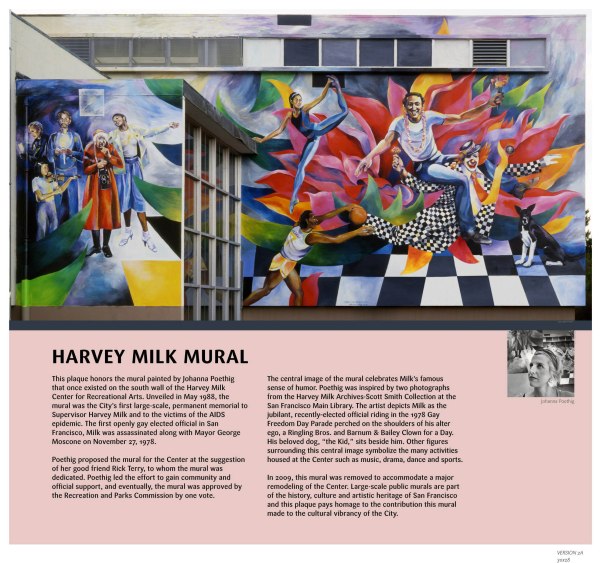
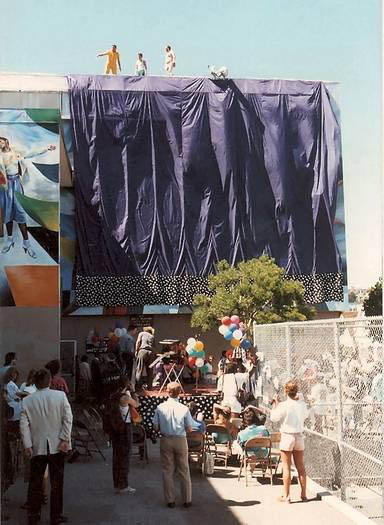

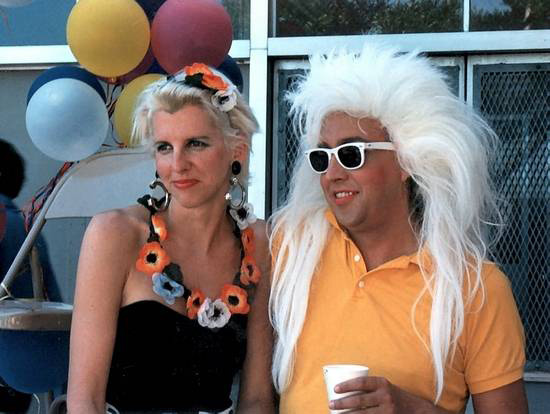
Wall Stories: Chavez, Cigars, Murals, Marxists and Manongs
Chavez, Cigars, Murals, Marxists and Manongs
I brought the wood cut outs along with the box full of acrylic paint jars. It was my second trip to Cuba during the “special period” of the 1990’s and this time I was going to paint a mural in Santiago as part of the international Internos project. Getting the paint onto American Airlines is another story, not because it was paint but because the jars were in boxes and boxes were not allowed on flights to Mexico during the holidays so people could not bring gifts to their families. Nice corporate policies. The wall in Santiago was still a mystery but the wall I was after was for the new Sonoma State Library so I was multi-tasking.
I was finalist in a competition to do a Cesar Chavez Memorial and I did not honestly expect to get the gig. I decided to do the mural out of layered wood cut outs that I could stain, carve, stencil and burn into. When I got to Santiago they were very disorganized so I had time to make my little wood cut out experimental maquette. The Cuban artists did not know who Cesar Chavez was. As I stuck the vinyl letters to spell out his quotes on the image of Chavez fasting I told his story. My fellow artists were barely interested in California labor history. They were very interested in the precious jars of acrylic colors and medium I had managed to get on the island via Mexico without a Cuba stamp on my passport. The lovely faded and distressed paint on their buildings was not a fancy first world art installation. They were somewhat more interested when I told them my great grandfather was a Marxist cigar maker, one of the German immigrants who had brought socialist ideas to America.
I really enjoyed making that maquette in the old Russian apartment building overlooking a big blue pool that was unswimmable because they had no chlorine. A small torture on hot humid days. On my first trip to Cuba to learn Afro Cuban Music and Dance, the pool at the University in Havana was emptied and filled every three days. I still got a yeast infection. Too much information but I always digress when it comes to swimming. The swimming pool at Sonoma State was big and chlorinated. The committee could not resist my layers of wood design and overall concept. I dare say it was quite a cute maquette and they kept it. I wish I still had it in my mountains of old proposals that will some day either be dumped or put in a climate controlled room. Your guess is as good as mine.
The Cesar Chavez Memorial Mural was a joy to paint. The Sonoma State Gallery was closed that summer so I had it all to myself. For a muralist these were premium conditions. The most illuminating part of the experience was meeting with the farm workers to talk about their experiences and reading the powerful words of Cesar Chavez. The other equally important part of the mural was placing the two Manongs, whose picture I found in an old newspaper, with Chavez at the center of the design. I stenciled the facts often overlooked in the history of the United Farm Workers. It was the Filipino workers who first voted to strike on September 8, 1965. A Cesar Chavez historian that I had consulted in my research objected to this centerpiece and emailed me angrily. Over the years I have also received appreciative emails from Filipino American students who did not know of this hard fought history.
2015 in pictures

Pajaro Park Mural
I have not had a moment to update this blog since the last entry. Well, maybe I could have taken a minute or two but there was always something pressing to do or a distraction to get my mind off what I have to do. Here is the first update. Spring 2014
Pajaro Park Mural. This was a tremendous effort over a 2 year period to plan and execute. As Artistic Director I led the process from working with the project architects to make sure the site was ready to receive a 300 foot mural painted off-site on special media, designing, teaching, painting , coordinating the artists and installing on a construction site. This mural brings vivid color and imagery to a park for the primarily farmworker community of Pajaro, California. Supported by the City and County of Monterey and the Monterey Arts Council and the Visual and Public Art Program, including contributions from alumni. John Elliott assisted me in the process and local artist Jose Ortiz worked with community to create a beautiful centerpiece.
High Stakes Divination Cards
Resonance of image and text is my form of divination. This set of High Stakes Divination Cards plays with the powers of suggestion. There is good fortune and then there is luck. There is chance and then circumstance. Predict your day. Choose a card to live by. Fortune telling is popular culture. Divination is a ritual of signs and omens in an attempt to organize seemingly unrelated events and logics. The dread and humor of daily life, the architecture of our social lives, the symbols of culture, odd behaviors, pleasures and pain, obsession with the tactics of empire, environmental meltdown and open sourced, random scavenged images are my vocabulary. to choose what fits best for that day, this era, that future.
Statue of Liberty mural restoration
MURAL RESTORATION COMPLETED!
Thanks to Jose Escobar, building engineer, Lessy Benedith, SOMA Homeless Shelter Program Director and David Curto from the Human Services Agency
John Elliott, Kyle Herbert who worked from the hot top planks down with the dogs barking into a frenzy all day from the kennel across the parking lot, Jorge Amezcua who came for a day and Matt Floriani who helped wrap it up.
Scaffolding taken down!
Country of Forgotten Dreams
“To Cause To Remember” by Johanna Poethig 1992
SOMA Multi Service Center – Homeless shelter
It is surprising when a work of art becomes a symbol with the lasting power to transform our public space and our conversation. This summer I was searched for and contacted by staff from the San Francisco Human Services Agency to restore my 1992 mural “To Cause to Remember”, better known as the Statue of Liberty mural. It is painted on the South of Market homeless shelter that serves the city of San Francisco. The Liberty is the leading spokes model for “America the Free” accompanied by her classic quote ending with“…Send These, The Homeless, Tempest-Tost To Me”. On the 40’x 80’ wall of the shelter Liberty lays on her side with chains on her feet and her hand outstretched. Two decades ago this symbol was approved for public space. In 2013, as much as we talk about social practice, social justice in our public arts and urban design, this is not an era when images with overt political content can easily get through a civic approval process. The public art field has grown dramatically with immense budgets, architectural integrations, technical and environmental innovations, and often a more design, as opposed to content, sensibility. Murals are the cave paintings of the public and community art movement. I have done many types of public art using a broad range of materials and community engaged projects in many corners of the urban environment. I actively invent new ways to engage public space and the constantly shifting “public”. Nothing, however, compares to the experience; physically, socially and politically, of what is sometimes considered the least innovative of public art processes – the painting of a mural on the street . The contact with the site and its inhabitants is sustained over time. The work is street theater. The image is massive. Corporate advertisers pay good money for this level of impact and that puts murals in direct competition with advertising. It is territorial. For a painter nothing matches it for a truly immersive artistic process. It demands hard labor, physical and mental fitness as well as the skills of an ambassador.
When I returned to the SOMA Homeless shelter to begin the restoration the site was once again a complicated mix of hospitality and tragedy. Everyone who comments on the mural mentions the chains first of all. New staff are brought out during their training to look at the mural and consider its meaning. This symbol, the fallen Liberty, speaks to the issues of poverty, immigration, mental illness, incarceration, drugs, war veterans, families and the elderly. The question is does this mural add something important to our experience of the city? It is does speak to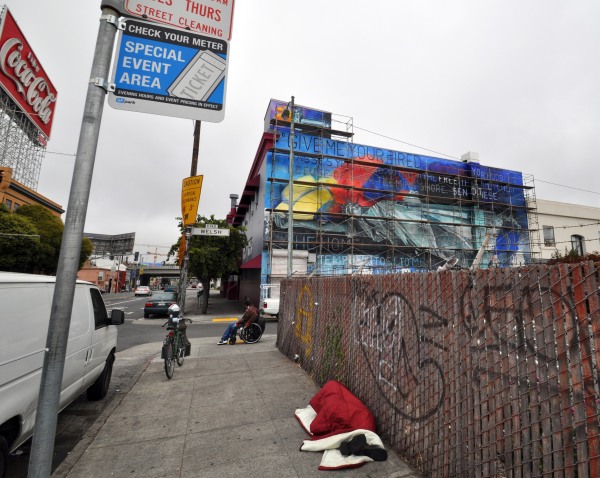 the people who are homeless and to the people who work to help them. It is an attraction or distraction to the residents of the city and a photo opportunity the tourists who pass through. The image has been published in books about street art. In my 30 year career as a muralist and public artist this work of art has weathered the test of time. The Liberty in recline has proven herself to really mean something to the people who live with her chains and to those who remember what she means.
the people who are homeless and to the people who work to help them. It is an attraction or distraction to the residents of the city and a photo opportunity the tourists who pass through. The image has been published in books about street art. In my 30 year career as a muralist and public artist this work of art has weathered the test of time. The Liberty in recline has proven herself to really mean something to the people who live with her chains and to those who remember what she means.
Working with John Elliott on restoration week 1.
Kyle Herbert and John at work
Jorge Amezcua and Matt Floriani, VPA students come to assist
Art Forum article
Art Forum article Nov 2012 Tri, Tri Again by Cathryn Drake
She took this great picture of the Tire Totem project. Zahkro’s son is having some fun in the back.

Hamilton Recreation Center Mosaics
Tbilisi Artisterium: Streetwise Tire Totems
The Protest that Never Ends
Artisterium 2012
The Artisterium V, the annual international contemporary art exhibition and series of public art events, opens in the Georgian capital of Tbilisi on October 5th, and runs through October 15, 2012.
“Artisterium” is an evolving curatorial platform. Each year, its overall theme always responds to timely social concerns, such as alternative ways of development (“Modus Operandi – in Quest of a Different Way”, 2008), changes on general and personal levels (“The Manifest of Changes and an Inner Experience”, 2009), artistic reflection on re-envisioning the future (“Imagine the Future”, 2010) and the willingness to embrace open-ended subjects as a way to critically engage with important social, political, urban, private and aesthetic issues (“Free Fall”, 2011).
The theme of the 2012 Artisterium V is “The Protest that Never Ends”. This theme offers an opportunity to research and showcase artistic and theoretical reflections on a wide range of PROTEST forms that we are currently experiencing globally. The show aims to provide a platform to explore what is worth protesting and how a creative work can become a “catalyst for changes”.
STREETWISE: AT ELIAVA BAZAAR
chuka Nino Kuprava, the founding curator of the project, is a textile painter. She is a co-founder of the Georgian Textile Group, and head of the Educational and Exposition Programs at the State Silk Museum Tbilisi.
curated by lydia Matthews (co-sponsored by the US Embassy in Tbilisi and the Curatorial Design Research Lab at Parsons The New School for Design, New York, USA)
Streetwise features seven artists/artist collectives from New York and California whose diverse projects in the public sphere have earned critical and popular acclaim. From large scale muralists with roots in graffiti art, to hip hop musician/writers, to artists who transformed a filthy city alley into a lush forested community park, to eco-oriented textile designers working in urban farmer’s markets, to researchers who facilitate virtual and actual cross-cultural think tanks aimed at solving problems in people’s daily lives–these artists understand the value of wisdom that can be generated by working with others to actively re-negotiate the urban environment. Streetwise highlights projects from the United States, but it also creates a platform to catalyze broader dialogues about new forms of participatory public art practice that are already emerging in the Republic of Georgia. It is meant to provoke the following question: what forms of knowledge can artists and designers use to re- envision their local environment, re-shaping it into a more vital, socially just and ecologically balanced place?
During Artisterium, Streetwise artists will work closely with local designers, artists, cultural activists, as well as Georgians they meet on the streets—to imagine interventions within the Eliava neighborhood and establish an international network for an ongoing exchange of creative knowledge. Georgian artistic collaborators include students/faculty from the tbilisi State academy of arts and the center for contemporary art tbilisi, artists from the Fleet Group, Urban Reactor, Group Bouillon, the Georgian textile Group, the State Silk Museum, la Maison Bleue, artists recently involved in “Batumi Backyards project,” as well as the eliava Group project team. They will engage two sites: Artisterium’s Karvalsa gallery (which will serve as an active workshop space and staging ground for planning the week’s off-site projects), and the Eliava neighborhood (where most of the projects will manifest.) Between Oct. 6-13th, U.S. artists will offer public talks, educational workshops and opportunities to co-design site-specific works within Eliava Bazaar. The project explores what it means to be “street-wise”, emphasizing open-ended, cross-cultural exchange and a spirit of subversive play. their exchange will culminate in an open House celebration at eliava Bazaar on Saturday, october 13th, to which the public is invited.
I must admit that I had barely heard of Tbilisi, Georgia before Lydia Matthews showed me the curatorial projects she had been working on there during my visit with her at Parsons in New York City. It still didn’t register until I got some an email from Laurie Lazer and Lydia while I was in Berlin. The US Embassy had come through with support to bring several artists from the United States to the Artisterium. Lydia, working with local textile artist Chuka, was planning Streetwise in the Eliava Bazaar and bringing artists who could intervene in this chaotic and challenging post soviet public market.
Lydia sent pictures of the market to us and once I saw the stacks of tires thought of Tire Temple, a project I had done in Oakland with refugee kids from Cambodian New Generation. I didn’t know how I would make this happen in Eliava but I started collecting materials for the project and the lecture/workshop I was scheduled to give at the Tbilisi Art Academy in hopes of getting some students interested in working with me. Just a few days before the Artisterium opening Georgia was having its first parliamentary election and there were major street protests over prison abuse by the current administration. There was worry that there would be violence. The Georgian Dream party won and there were no protests while we were there.
On Monday we went to Eliava. The sprawling market is a graveyard of crashed cars. We wound around the market till we came to rows and rows of stacked tires. At one corner was a particularly appealing tire set up with a view to the city behind it. Chuka introduced me to the merchant of this tire stall and the project began. Zakhro was welcoming, helpful and ready to be part of this strange art event that came come his way. I asked him what he wanted me to paint and he quickly answered a lion and eagle.
The paint was fast drying toxic car enamel. The masks minimal but effective enough. It drizzled and got muddy. Eli, a young artist who volunteered to help me communicate quickly became a creative collaborator. Zahkro collected the discarded tires from the roofs and prepped them for us.
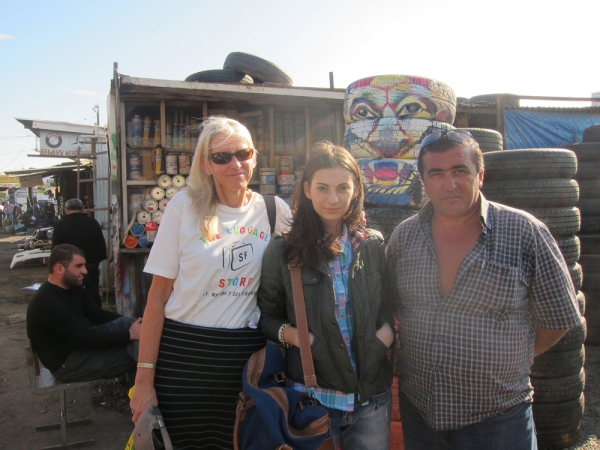
I gave a lecture and had a workshop at the Tbilisi Art Academy. A group of students got excited about the project and decided to come work on it.
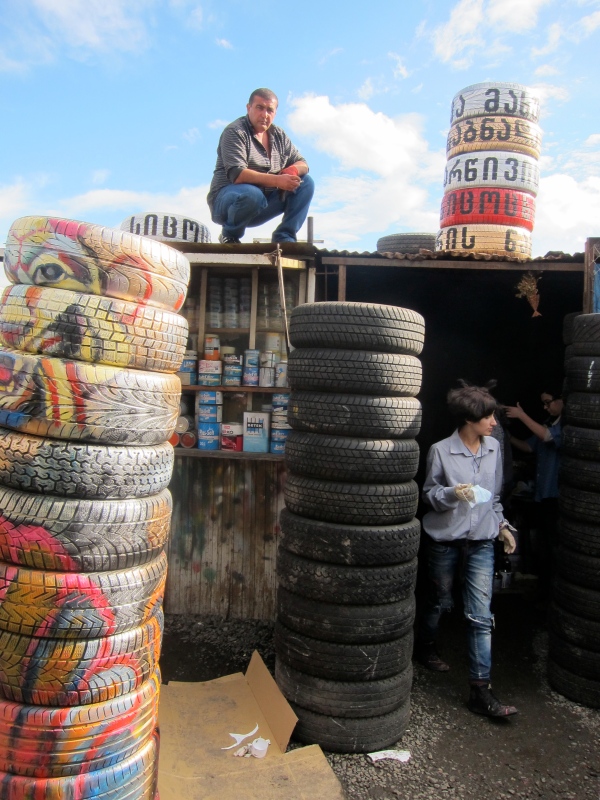
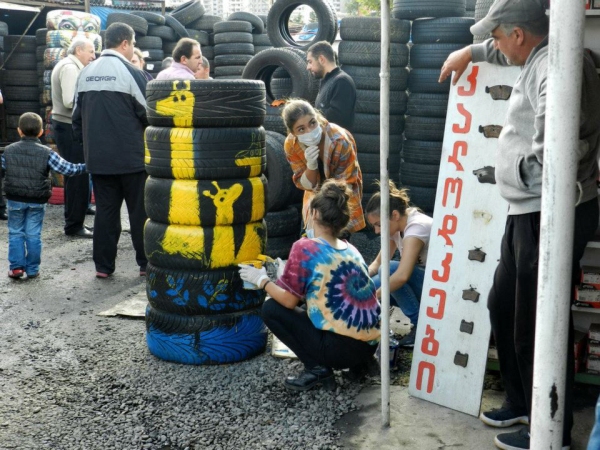
Saturday’s opening was a transformation of social places and spaces.
